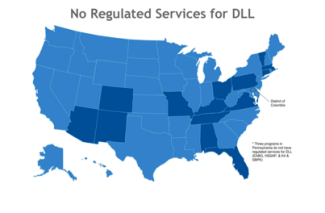
What the State of Preschool can tell us about Dual Language Learners in state programs
October 21, 2015
The NIEER State of Preschool Yearbook collects data on a variety of topics relating to early childhood, including how states are serving dual language learners. According to Child Trends, nearly 22 percent of U.S. children live in a household that speaks a language other than English, therefore, it is important to analyze what supports early childhood programs are providing for students and families who speak a language other than English. [WIDA]
Dual language learners account for a growing population of young children, and providing strong supports for DLL children early can contribute to their long-term success. NAEYC suggests ensuring linguistically inclusive environments so children can communicate freely, as well as talking, singing, reading, and other activities that build a child’s vocabulary while providing increased opportunities to develop listening skills. NIEER’s policy brief Preparing Young Hispanic Dual Language Learners for a Knowledge Economy, specifically talks about the importance of access and quality for young Hispanic children, though much of the information provided can be applied to children from other minority language and cultural backgrounds as well.
The NIEER State of Preschool Yearbook asked states what support services their program offers to English language learners; below is a breakdown of some of these supports and why they are necessary for academic growth. It should be noted that the Yearbook survey asks about supports that are written into policy. In practice, supports may be provided beyond what is noted, and may be determined locally, at the discretion of local districts and providers.
Thirteen state programs require a systematic written plan on how to work with dual language learners in order to ensure quality and consistency:

Eleven programs provide professional development or coaching to teachers to enhance teaching to children who are dual language learners:

Twenty programs are required to screen and assess all children to determine home language. Districts are required to assess children in their home language, according to the Individuals with Disabilities Act (IDEA) Part C and Part B. Research has shown, however, that programs struggle to assess in their home language children who might also have a learning disability. Language issues in assessment can lead to an over- or under-identification of actual disabilities–often, children may be classified as having a learning disability, when in fact, they have difficulty communicating in the language in which they were tested. It is important to know which states screen and assess children to identify dual language learners, to more clearly understand these issues, and begin to provide the necessary accommodations where necessary.

To learn more about screening DLL and special needs, see CEELO’s Fast Fact, Training to Screen Young ELLs and DLLS for Disabilities.
Seventeen programs provide information in the family’s home language to parents. It is essential for programs to be able to communicate effectively with the child’s family, as parent engagement is a key element of good practice.

As noted above, in many states there is no specified policy around providing services for Dual Language Learners and their families; decisions are instead made locally. The Yearbook survey to states asks How many English language Learners are served in the program?; only 18 state programs among those responding are able to answer with a number or percent. The survey also provides a checklist for states to outline services to provided to ELL families, including: Bilingual non-English classes are permitted in pre-K; Professional development or coaching is provided for teachers; Programs are required to screen and assess all children; Translators or bilingual staff are available if children do not speak English; A home language survey is sent home at the beginning of the year; Information must be presented to parents in their primary language; and A systematic, written plan must be in place on how to work with English Language Learners. Many states have policies requiring at least some of these elements within the state program, yet 17 programs answered that they ‘do not regulate services’ for DLL’s at all.

As the population changes, it would be helpful to understand how many children whose first language is not English are being served in state programs, as well as understanding more clearly what supports and practices can best serve those children and their families. To that end, NIEER has included in its 2015 State of Preschool Yearbook survey a number of supplemental questions on this topic, including more detailed information about the number of children served, and questions about the ways that teachers, children, and families are supported within state programs. We hope that this new data will help to inform the field as it works to assess how best to serve DLL children.
–Michelle Horowitz, NIEER Assistant Research Project Coordinator
About NIEER
The National Institute for Early Education Research (NIEER) at the Graduate School of Education, Rutgers University, New Brunswick, NJ, conducts and disseminates independent research and analysis to inform early childhood education policy.
